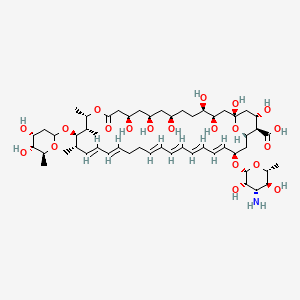Nystatin A3
Nystatin A3 is a lipid of Polyketides (PK) class. Nystatin a3 is associated with abnormalities such as Mycoses, Candidiasis of the genitals and Gigantism. The involved functions are known as Drug Interactions, Process, Synthesis, Fermentation and Anabolism. Nystatin a3 often locates in Cell membrane, Membrane, Protoplasm, Entire oral cavity and integral to membrane. The associated genes with Nystatin A3 are Gene Clusters. The related lipids are Sterols, 1,2-oleoylphosphatidylcholine, Membrane Lipids, DOPE and N-caproylsphingosine.
Cross Reference
Introduction
To understand associated biological information of Nystatin A3, we collected biological information of abnormalities, associated pathways, cellular/molecular locations, biological functions, related genes/proteins, lipids and common seen animal/experimental models with organized paragraphs from literatures.
What diseases are associated with Nystatin A3?
Nystatin A3 is suspected in Mycoses, Candidiasis of the genitals, Gigantism and other diseases in descending order of the highest number of associated sentences.
Related references are mostly published in these journals:
| Disease | Cross reference | Weighted score | Related literature |
|---|
Possible diseases from mapped MeSH terms on references
We collected disease MeSH terms mapped to the references associated with Nystatin A3
PubChem Associated disorders and diseases
What pathways are associated with Nystatin A3
There are no associated biomedical information in the current reference collection.
PubChem Biomolecular Interactions and Pathways
Link to PubChem Biomolecular Interactions and PathwaysWhat cellular locations are associated with Nystatin A3?
Visualization in cellular structure
Associated locations are in red color. Not associated locations are in black.
Related references are published most in these journals:
| Location | Cross reference | Weighted score | Related literatures |
|---|
What functions are associated with Nystatin A3?
Related references are published most in these journals:
| Function | Cross reference | Weighted score | Related literatures |
|---|
What lipids are associated with Nystatin A3?
Related references are published most in these journals:
| Lipid concept | Cross reference | Weighted score | Related literatures |
|---|
What genes are associated with Nystatin A3?
Related references are published most in these journals:
| Gene | Cross reference | Weighted score | Related literatures |
|---|
What common seen animal models are associated with Nystatin A3?
There are no associated biomedical information in the current reference collection.
NCBI Entrez Crosslinks
All references with Nystatin A3
Download all related citations| Authors | Title | Published | Journal | PubMed Link |
|---|---|---|---|---|
| Kristanc L et al. | Effects of the pore-forming agent nystatin on giant phospholipid vesicles. | 2012 | Biochim. Biophys. Acta | pmid:22178865 |
| Kaufman DA | "Getting to Zero": preventing invasive Candida infections and eliminating infection-related mortality and morbidity in extremely preterm infants. | 2012 | Early Hum. Dev. | pmid:22633513 |
| Khan MA et al. | Immune stimulating and therapeutic potential of tuftsin-incorporated nystatin liposomes against Cryptococcus neoformans in leukopenic BALB/C mice. | 2012 | FEMS Immunol. Med. Microbiol. | pmid:22612788 |
| Shanmughapriya S et al. | In vitro actinomycete biofilm development and inhibition by the polyene antibiotic, nystatin, on IUD copper surfaces. | 2012 | Biofouling | pmid:22963125 |
| Kaomongkolgit R et al. | Antifungal activity of coronarin D against Candida albicans. | 2012 | Oral Surg Oral Med Oral Pathol Oral Radiol | pmid:22727093 |
| Fernández Campos F et al. | Development and characterization of a novel nystatin-loaded nanoemulsion for the buccal treatment of candidosis: ultrastructural effects and release studies. | 2012 | J Pharm Sci | pmid:22777575 |
| Baugé C et al. | Regulatory mechanism of transforming growth factor beta receptor type II degradation by interleukin-1 in primary chondrocytes. | 2012 | Biochim. Biophys. Acta | pmid:22425785 |
| Leibovitz E | Strategies for the prevention of neonatal candidiasis. | 2012 | Pediatr Neonatol | pmid:22503254 |
| Bhattacharya S et al. | DNA conjugated SWCNTs enter endothelial cells via Rac1 mediated macropinocytosis. | 2012 | Nano Lett. | pmid:22375622 |
| Al-Dwairi ZN et al. | The effect of antifungal agents on surface properties of poly(methyl methacrylate) and its relation to adherence of Candida albicans. | 2012 | J Prosthodont Res | pmid:22841909 |
| Giglio M et al. | Oral nystatin prophylaxis in surgical/trauma ICU patients: a randomised clinical trial. | 2012 | Crit Care | pmid:22490643 |
| Xu L et al. | Epirubicin enhances TRAIL-induced apoptosis in gastric cancer cells by promoting death receptor clustering in lipid rafts. | 2011 May-Jun | Mol Med Rep | pmid:21468584 |
| Brito GN et al. | In vitro antifungal susceptibility of Candida spp. oral isolates from HIV-positive patients and control individuals. | 2011 Jan-Feb | Braz Oral Res | pmid:21271179 |
| Mane RS et al. | Synthesis of an adenine nucleoside containing the (8'R) epimeric carbohydrate core of amipurimycin and its biological study. | 2011 | J. Org. Chem. | pmid:21381774 |
| Jeon HG et al. | Analysis and functional expression of NPP pathway-specific regulatory genes in Pseudonocardia autotrophica. | 2011 | J. Ind. Microbiol. Biotechnol. | pmid:21259033 |
| Acar A et al. | Comparison of silver-coated dressing (Acticoat®), chlorhexidine acetate 0.5% (Bactigrass®) and nystatin for topical antifungal effect in Candida albicans-contaminated, full-skin-thickness rat burn wounds. | 2011 | Burns | pmid:21354707 |
| Villa NY et al. | Phylogenetic and preliminary phenotypic analysis of yeast PAQR receptors: potential antifungal targets. | 2011 | J. Mol. Evol. | pmid:22009226 |
| Frey Tirri B | Antimicrobial topical agents used in the vagina. | 2011 | Curr. Probl. Dermatol. | pmid:21325838 |
| Brautaset T et al. | New nystatin-related antifungal polyene macrolides with altered polyol region generated via biosynthetic engineering of Streptomyces noursei. | 2011 | Appl. Environ. Microbiol. | pmid:21764946 |
| Chao TY and Raines RT | Mechanism of ribonuclease A endocytosis: analogies to cell-penetrating peptides. | 2011 | Biochemistry | pmid:21827164 |
